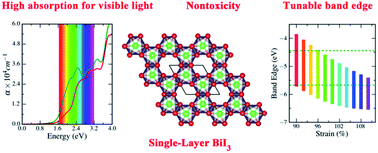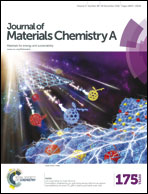Theoretical perspective of energy harvesting properties of atomically thin BiI3
Abstract
The emergence of inorganic–organic lead-halide perovskites has revolutionized solar cells due to their high power conversion efficiency; however, the toxicity of Pb leads to severe environmental concerns for their large-scale implementation. It is thus of great interest to explore non-toxic alternative materials for overcoming the existing energy challenge. In the present paper, we have investigated a nontoxic layered heavy-element compound BiI3 and its single layer comparatively using density functional theory with and without spin—orbit coupling (SOC) effect. The SOC effect is found to play a decisive role in the band gap and band edge of single layer BiI3. Our results indicate that single-layer BiI3 can be easily exfoliated from the bulk crystal and can be stable even above 600 K, as confirmed by the phonon dispersions and ab initio molecular dynamics simulations. The PBE + SOC calculation predicts that the single-layer BiI3 has an indirect band gap of 1.63 eV and high absorption for visible light. Moreover, we also find that the electronic structure of single-layer BiI3 can be tuned by biaxial strain and a small compressive strain of about 4% can make the absolute band edges straddle water redox potentials. Finally, the predicted acoustic-phonon-limited carrier mobilities are electron dominated and highly asymmetric. And the electron mobilities are found to be above 200 cm2 V−1 s−1. The unique combination of the suitable energy gap, tunable band edge, and moderate carrier mobilities predicted here makes single-layer BiI3 a promising candidate for future low-dimensional solar energy conversion applications.



 Please wait while we load your content...
Please wait while we load your content...